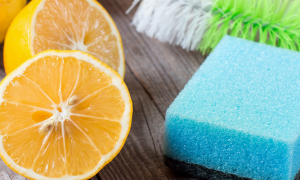The Best Ways to Store Fruits and Veggies
How do you store veggies and fruits? What can stay out on the counter and what needs to go in the fridge?
Guest post by Jennifer Tuohy

To keep your food fresh, it’s important to know how to use the crisper drawers of your refrigerator properly. Follow the tips below for the best way to store fruits and vegetables both inside and outside of your refrigerator.
In a Cool, Dark Place
Never store these items in the fridge. Your pantry is a great place for these fruits and veggies, which do best out of the sunlight:
Veggies:
- Garlic
- Onion
- Sweet potatoes
- Winter squash
Fruit:
- Melons
On the Counter
These items will do fine on the counter for three to five days, if you leave them whole. Put any produce that needs to ripen in a brown paper bag for a few days to speed up the process. For longer storage, transfer produce to your fridge’s low-humidity drawer.
Veggies:
- Asparagus and celery —Stand these up in a shallow glass of water.
- Avocados
- Cabbage
- Eggplant
- Kale, collards, and chard — These also do well in a shallow glass of water.
- Summer squash
- Tomatoes
Fruit:
- Apples
- Bananas
- Citrus fruits — Keep these in a bowl with plenty of air circulation.
- Kiwis
- Mangoes
- Pears
- Pineapples

In the Low-Humidity Drawer
Produce that can dry out a little should go in this drawer, with the humidity slider open. This drawer is one-step removed from the main fridge, slightly less chilled but still dry. Store any cut or sliced fruits and veggies here. Place these types of produce directly into the drawer:
Veggies:
- Corn — Leave it in the husk.
- Peppers — Store them in a plastic bag.
Fruit:
- Apples — Store them here if you like them cold.
- Ripe stone fruits, such as peaches and plums — Leave them in the drawer as-is.
In the High-Humidity Drawer
Produce that needs a moist environment goes in here, with the humidity slider closed so that water vapor is held in the drawer to keep things fresher for longer. Fruit does not keep well in a high-humidity drawer.
- Beets — Cut off the tops, then store the beets in a plastic bag with a damp paper towel.
- Broccoli
- Carrots
- Green beans — Keep these in a plastic bag with a damp paper towel.
- Leafy greens like lettuce and spinach — Wash and dry them thoroughly first.
In the Main Fridge Compartment
- Fresh herbs — Store them wrapped in a damp paper towel in an airtight container.
- Mushrooms — Keep them in their packaging or a brown paper bag.
- Berries and grapes — Store them unwashed. Wash them just before you’re ready to eat them.
One of the best advantages of storing fruits and veggies in their proper place is that you are far less likely to end up with a crowded crisper drawer, which leads to soggy forgotten food. Your crisper drawers are indispensable for keeping produce fresh, but only if you use them correctly. Also, if you keep lots of produce sitting out on the counter, you could find yourself and your family reaching for it more often than bags of chips in the cupboard.
Jennifer Tuohy writes for The Home Depot on a variety of topics, including trends in smart appliances and tips for shopping for a new fridge. Click here to see The Home Depot’s selection of refrigerators.




